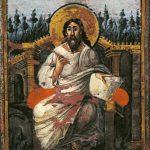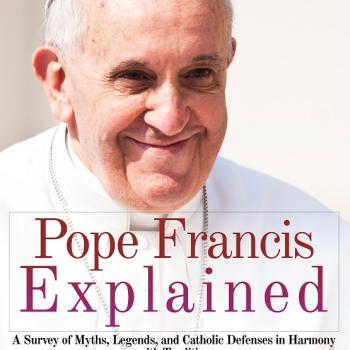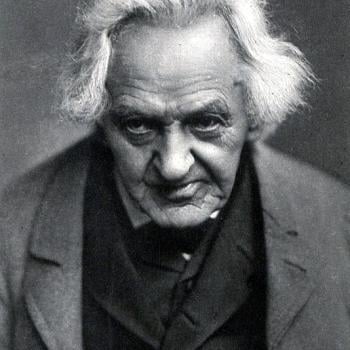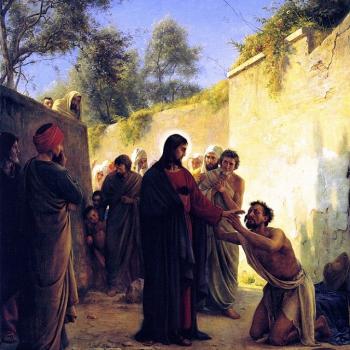In the Septuagint (the Greek translation of the Old Testament), episkopos is used for overseer in various senses, for example: officers (Judges 9:28, Isaiah 60:17), supervisors of funds (2 Chronicles 34:12,17), overseers of priests and Levites (Nehemiah 11:9, 2 Kings 11:18), and of temple and tabernacle functions (Numbers 4:16). God is called episkopos at Job 20:29, referring to His role as Judge, and Christ is an episkopos in 1 Peter 2:25 (RSV: “Shepherd and Guardian of your souls”).
The Council of Jerusalem (Acts 15:1-29) bears witness to a definite hierarchical, episcopal structure of government in the early Church. St. Peter, the chief elder (the office of pope) of the entire Church (1 Peter 5:1; cf. John 21:15-17), presided and issued the authoritative pronouncement (15:7-11). Then James, bishop of Jerusalem (kind of like the host-mayor of a conference) gives a concurring (Acts 15:14), concluding statement (15:13-29). That James was the sole, “monarchical” bishop of Jerusalem is fairly apparent from Scripture (Acts 12:17, 15:13,19, 21:18, Galatians 1:19, 2:12). This fact is also attested by the first Christian historian, Eusebius (History of the Church, 7:19).
Much historical and patristic evidence also exists for the bishopric of St. Peter at Rome. No one disputes the fact that St. Clement (d.c.101) was the sole bishop of Rome a little later, or that St. Ignatius (d.c.110) was the bishop at Antioch, starting around 69 A.D. Thus, the “monarchical” bishop is both a biblical concept and an unarguable fact of the early Church. By the time we get to the mid-second century, virtually all historians hold that single bishops led each Christian community. This was to be the case in all Christendom, east and west, until Luther transferred this power to the secular princes in the 16th century, and the Anabaptist tradition eschewed ecclesiastical office either altogether or in large part. Today many denominations have no bishops whatsoever.
One may concede all the foregoing as true, yet deny apostolic succession, whereby these offices are passed down, or handed down, through the generations and centuries, much like Sacred Tradition. But this belief of the Catholic Church (along with Eastern Orthodoxy and Anglicanism) is also grounded in Scripture:
St. Paul teaches us (Ephesians 2:20) that the Church is built on the foundation of the apostles, whom Christ Himself chose (John 6:70, Acts 1:2,13; cf. Matthew 16:18). In Mark 6:30 the twelve original disciples of Jesus are called apostles, and Matthew 10:1-5 and Revelation 21:14 speak of the twelve apostles. After Judas defected, the remaining eleven Apostles appointed his successor, Matthias (Acts 1:20-26). Since Judas is called a bishop (episkopos) in this passage (1:20), then by logical extension all the Apostles can be considered bishops (albeit of an extraordinary sort).
If the Apostles are bishops, and one of them was replaced by another, after the death, Resurrection, and Ascension of Christ, then we have an explicit example of apostolic succession in the Bible, taking place before 35 A.D. In like fashion, St. Paul appears to be passing on his office to Timothy (2 Timothy 4:1-6), shortly before his death, around 65 A.D. This succession shows an authoritative equivalency between Apostles and bishops, who are the successors of the Apostles. As a corollary, we are also informed in Scripture that the Church itself is perpetual, infallible, and indefectible (Matthew 16:18, John 14:26, 16:18). Why should the early Church be set up in one form and the later Church in another?
All of this biblical data is harmonious with the ecclesiological views of the Catholic Church. There has been some development over the centuries, but in all essentials, the biblical Church and clergy and the Catholic Church and clergy are one and the same.
The historical evidence of the earliest Christians after the Apostles and the Church Fathers is quite compelling as well: there exists virtually unanimous consent as to the episcopal, hierarchical, visible nature of the Church, which proceeds authoritatively down through history by virtue of Apostolic Succession.
St. Clement, bishop of Rome (d.c.101), teaches apostolic succession, around 80 A.D. (Epistle to Corinthians, 42:4-5, 44:1-3), and St. Irenaeus is a very strong witness to, and advocate of this tradition in the last two decades of the 2nd century (Against Heresies, 3:3:1,4, 4:26:2, 5:20:1, 33:8). Eusebius, the first historian of the Church, in his History of the Church, c.325, begins by saying that one of the “chief matters” to be dealt with in his work is “the lines of succession from the holy apostles . . .” (tr. G.A. Williamson, Baltimore: Penguin Books, 1965, 31).
With regard to the threefold ministry of bishop, priest (elder/presbyteros), and deacon, St. Ignatius, bishop of Antioch, offers remarkable testimony, around 110 (Letter to the Magnesians, 2, 6:1, 13:1-2, Letter to the Trallians, 2:1-3, 3:1-2, 7:2, Letter to the Philadelphians, 7:1-2, Letter to the Smyrnaeans, 8:1-2 – the last also being the first reference to the “Catholic Church”). St. Clement of Rome refers to the “high priest” and “priests” of Christians around 96 (1 Clement, 40). Other prominent early witnesses include St. Hippolytus (Apostolic Tradition, 9) and St. Clement of Alexandria (Stromateis, 6:13:107:2), both in the early third century.
Even John Calvin, contrary to many of his later followers, taught that the Church was visible and a “Mother” (Institutes of the Christian Religion, IV,1,1; IV,1,4; IV,1,13-14), the wrongness of sectarianism and schism (IV,1,5; IV,1,10-15), and that the Church includes sinners and “hypocrites” (IV,1,7; IV,1,13-15 – he cites Matthew 13:24-30,47-58). His difference with Catholics here is that he defines the visible Church as his own Reformed Church.
*****
Meta Description: Basic biblical arguments in favor of the traditional Catholic understanding of the nature of the historic Catholic Church.
Meta Keywords: Catholic, visible church, apostolic church, hierarchical church, hierarchy, magisterium, Catholic authority, church authority, Church government, church infallibility, conciliar infallibility, infallibility, papal authority, papal infallibility, Rule of Faith, Three-Legged Stool













